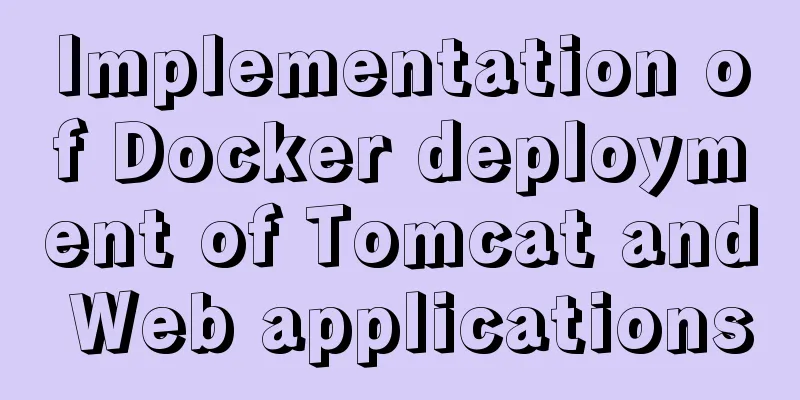Detailed tutorial on deploying apollo with docker

|
1. Introduction I won’t go into details about apollo here. The official website https://github.com/ctripcorp/apollo has already explained it very clearly. I won’t explain it here. If you don’t know it yet, you can go to the official website to learn more. This article just records how I deployed Apollo and its cluster using docker, sharing it with everyone and making a record for myself. Note: I started with direct deployment, and I created and initialized the database myself according to the official website. 2. Source code compilation 2.1 Network Strategy The network policy can be directly used as described on the official website. Specifically, edit apollo-configservice/src/main/resources/application.yml and apollo-adminservice/src/main/resources/application.yml respectively, and then add the network card to be ignored. The following example shows that for apollo-configservice, the docker0 and veth.* network cards are ignored when they are registered with Eureka.
spring:
application:
name: apollo-configservice
profiles:
active: ${apollo_profile}
cloud:
inetutils:
ignoredInterfaces:
-docker0
-veth.*
Note: Be careful when modifying application.yml and do not make mistakes in other information, such as spring.application.name. 2.2 Dynamically specifying a registered network When using Docker to build a cluster, both adminservice and configservice need to register their addresses with the registration center. If the registration IP is not specified, the network inside Docker will be registered, resulting in network disconnection. Add the following code to apollo-configservice/src/main/resources/bootstrap.yml and apollo-adminservice/src/main/resources/bootstrap.yml.
eureka:
instance:
ip-address: ${eureka.instance.ip-address}
The value here is taken from the environment variable, and configuration outside the container brings greater flexibility to deployment. At this point, the source code modification has been completed, and you can directly build and package it to get the zip packages corresponding to the three services. If you are too lazy to modify it, you can also directly download the modified source code from https://github.com/yuelicn/apollo. and package it directly. 3. Dockerfile writing Apollo's Dockerfile is very simple, you can just use the one provided by the official website. Below is an example of adminservice.
# Dockerfile for apollo-adminservice
# Build with:
# docker build -t apollo-adminservice .
# Run with:
# docker run -p 8090:8090 -d --name apollo-adminservice apollo-adminservice
FROM java:8-jre
MAINTAINER Louis
ENV VERSION 1.5.0
RUN apt-get install unzip
ADD apollo-adminservice-${VERSION}-github.zip /apollo-adminservice/apollo-adminservice-${VERSION}-github.zip
RUN unzip /apollo-adminservice/apollo-adminservice-${VERSION}-github.zip -d /apollo-adminservice \
&& rm -rf /apollo-adminservice/apollo-adminservice-${VERSION}-github.zip \
&& sed -i '$d' /apollo-adminservice/scripts/startup.sh \
&& echo "tail -f /dev/null" >> /apollo-adminservice/scripts/startup.sh
EXPOSE 8090
CMD ["/apollo-adminservice/scripts/startup.sh"]
It should be noted that 1: version needs to be modified according to the version you package The Dockerfile files of the three services are basically the same, so I won’t go into details here. Friends who need it can download it directly from https://github.com/yuelicn/docker-apollo. 4 Writing docker-compose 4.1 apollo-configservice-compose.yml version: "3" services: apollo-configservice: container_name: apollo-configservice build: apollo-configservice/ image: apollo-configservice ports: - 8080:8080 volumes: - "/docker/apollo/logs/100003171:/opt/logs/100003171" environment: - spring_datasource_url=jdbc:mysql://127.0.0.1:8306/ApolloConfigDB_TEST?characterEncoding=utf8 -spring_datasource_username=root -spring_datasource_password=mysql2019* -eureka.instance.ip-address=172.11.11.11 restart: always Things to note, 1: Specify the location of your Dockerfile in build: Special note: Before starting, it is best to modify the eureka.service.url value in ServerConfig in the ApolloConfigDB database to a specific IP docker-compose -f apollo-configservice-compose.yml up --build -d 4.2 apollo-adminservice-compose.yml The content of apollo-adminservice-compose.yml is basically the same as apollo-configservice-compose.yml, so I won't explain them one by one here. 4.3 apollo-portal-compose.yml version: "3" services: apollo-portal: container_name: apollo-portal build: apollo-portal/ image: apollo-portal ports: -8070:8070 volumes: - "/docker/apollo/logs/100003173:/opt/logs/100003173" - "/apollo-portal/config/apollo-env.properties:/apollo-portal/config/apollo-env.properties" environment: - spring_datasource_url=jdbc:mysql://127.0.0.1:8306/ApolloPortalDB?characterEncoding=utf8 -spring_datasource_username=root -spring_datasource_password=mysql2019* restart: always Note: docker-compose -f apollo-configservice-compose.yml up --build -d 4.3.1 apollo-env.properties
local.meta=http://localhost:8080
dev.meta=${dev_meta}
fat.meta=${fat_meta}
uat.meta=${uat_meta}
lpt.meta=${lpt_meta}
pro.meta=${pro_meta}Configure your own meta address, if you don’t have one, you can delete it directly. If you don't understand, you can go to the official website to learn more. After the environment is configured, modify the apollo.portal.envs value in ApolloPortalDB.ServerConfig in the corresponding database and fill in your configured environment. Otherwise, we can only see the default dev environment on the portal management page. 5 Complete docker-compose.yml If you don't like the hassle of starting one by one, you can also use a complete compose to start. version: "3" services: apollo-configservice: container_name: apollo-configservice build: apollo-configservice/ image: apollo-configservice ports: - 8080:8080 volumes: - "/docker/apollo/logs/100003171:/opt/logs/100003171" environment: - spring_datasource_url=jdbc:mysql://47.xx.xx.209:8306/ApolloConfigDB?characterEncoding=utf8 -spring_datasource_username=root -spring_datasource_password=Tusdao@xx* -eureka.instance.ip-address=172.11.11.11 restart: always apollo-adminservice: container_name: apollo-adminservice build: apollo-adminservice/ image: apollo-adminservice ports: -8090:8090 volumes: - "/docker/apollo/logs/100003172:/opt/logs/100003172" environment: - spring_datasource_url=jdbc:mysql://47.xx.xx.209:8306/ApolloConfigDB?characterEncoding=utf8 -spring_datasource_username=root -spring_datasource_password=Tusdao@xx* -eureka.instance.ip-address=172.11.11.11 depends_on: - apollo-configservice restart: always apollo-portal: container_name: apollo-portal build: apollo-portal/ image: apollo-portal ports: -8070:8070 volumes: - "/docker/apollo/logs/100003173:/opt/logs/100003173" - "/Apollo/docker-image/apollo-portal/config/apollo-env.properties:/apollo-portal/config/apollo-env.properties" environment: - spring_datasource_url=jdbc:mysql://47.xx.xx.209:8306/ApolloPortalDB?characterEncoding=utf8 -spring_datasource_username=root -spring_datasource_password=Tusdao@xx* depends_on: - apollo-adminservice restart: always Note: The places that need to be modified are basically the same as for the single one, so I won’t go into details here. At this point, docker deployment of Apoll is basically done. If you need a complete docker deployment file, please go to https://github.com/yuelicn/docker-apollo 6 Cluster Construction The construction of Apollo cluster is very simple. You only need to modify two places. We will use the formal environment (pro) to illustrate. 1: Write both the eureka.service.url value and the eureka connection information in ServerConfig separated by commas: http://IP-1:port/eureka, http://IP-2:port/eureka 2: Modify the connection information of the corresponding environment in apollo-env.properties, such as: pro.meta=http://IP-1:port,http://IP-2:port. The addresses can be separated by commas. Then restart the service and it's done. Finally, it is emphasized that adminservice and configservice need to be deployed separately for each environment, including the database. Only one set of portal needs to be deployed. OK! Done. The above is my personal build record. I hope it helps you. If there is anything wrong, please correct me. Modified source code address: https://github.com/yuelicn/apollo The organized Docker-Apollo: https://github.com/yuelicn/docker-apollo The above is the full content of this article. I hope it will be helpful for everyone’s study. I also hope that everyone will support 123WORDPRESS.COM. You may also be interested in:
|
<<: MySQL Server IO 100% Analysis and Optimization Solution
>>: Pitfalls and solutions for upgrading MySQL 5.7.23 in CentOS 7
Recommend
Vue implements zoom in, zoom out and drag function
This article example shares the specific code of ...
How to implement responsiveness in Vue source code learning
Table of contents Preface 1. Key Elements of a Re...
Summary of several postures that must be mastered in Linux compilation optimization
01. Compile options and kernel compilation The Li...
Implementing a simple age calculator based on HTML+JS
Table of contents Preface Demonstration effect HT...
A brief discussion on the lazy loading attribute pattern in JavaScript
Table of contents 1. Introduction 2. On-demand at...
MySQL View Principle Analysis
Table of contents Updatable Views Performance of ...
Perfect solution to the problem of webpack packaging css background image path
Inside the style tag of the vue component, there ...
Details of the order in which MySQL reads my.cnf
Table of contents The order in which MySQL reads ...
CentOS8 network card configuration file
1. Introduction CentOS8 system update, the new ve...
MySQL join buffer principle
Table of contents 1. MySQL join buffer 2. JoinBuf...
Click on the anchor link in JS to scroll smoothly and adjust to the top position freely
Click on the anchor link to scroll smoothly and a...
How to use the WeChat Mini Program lottery component
It is provided in the form of WeChat components. ...
A brief analysis of SpringBoot packaging and uploading to docker and implementing multi-instance deployment (IDEA version)
Recently a friend asked me if I have ever played ...
Detailed steps for installing nodejs environment and path configuration in Linux
There are two ways to install nodejs in linux. On...
Comment reply pop-up mask effect implementation idea compatible with ie 8/chrome/firefox
I like to pay attention to some news on weekdays a...









